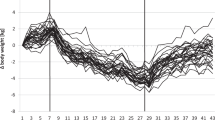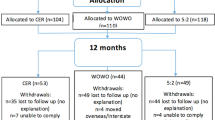Abstract
Background
The measurement of energy intake is central to the understanding of energy balance and predicting changes in body weight. Until recently, the most commonly used methods of assessing intake were self-reported diet recalls, diet diaries, or food-frequency questionnaires. These methods, however, are subject to systematic biases and are often inaccurate.
Aim
Review the validations and applications of an expenditure/balance method for measuring energy intake.
Methods
Review the literature regarding the theory and practice of objectively measuring energy intake based on the principle of energy balance i.e., energy intake is calculated from the measured total energy expenditure plus the change in body energy stores (ES). The attainable precision is modeled and compared with the accuracy and precision of validations against known energy intake.
Results
Measurement of energy intake, calculated in this way, is accurate to within 2% and has a precision of 4–37% depending on the expenditure and body composition methods used and the time interval between measures. Applications of this expenditure/balance (EB) method have provided novel data on the compliance to dietary restriction and its association with physical activity interventions, and the effects of bariatric surgery on energy intake and weight gain. Practical limitations to this method, however, include cost and limited access to the analyses required by the DLW method.
Conclusion
The EB method of objectively measuring energy intake is objective, accurate, and reasonably precise. It is practical for moderate-sized studies.
This is a preview of subscription content, access via your institution
Access options
Subscribe to this journal
Receive 12 print issues and online access
$259.00 per year
only $21.58 per issue
Buy this article
- Purchase on Springer Link
- Instant access to full article PDF
Prices may be subject to local taxes which are calculated during checkout

Similar content being viewed by others
References
Hall KD, Heymsfield SB, Kemnitz JW, Klein S, Schoeller DA, Speakman JR. Energy balance and its components: implications for body weight regulation. Am J Clin Nutr. 2012;95:989–94.
Hill JO, Wyatt HR, Peters JC. Energy balance and obesity. Circulation. 2012;126:126–32.
Lam YY, Ravussin E. Analysis of energy metabolism in humans: a review of methodologies. Mol Metab. 2016;5:1057–71.
Levine JA. Measurement of energy expenditure. Public Health Nutr. 2005;8:1123–32.
Lam YY, Ravussin E. Indirect calorimetry: an indispensable tool to understand and predict obesity. Eur J Clinical Nutr. 2017;71:318–22.
Speakman JR. The history and theory of the doubly labeled water technique. Am J Clin Nutr. 1998;68:932s–8s.
Atwater WO, Bryant AP. The availability and fuel values of food materials. Agricultural Experiment Station 12th Annual Report, Connecticut (Storrs); 1899, 1900.
Maclean W, Harnly J, Chen J, Chevassus-Agnes S, Gilani G, Livesey G, editors. Food energy—methods of analysis and conversion factors. Food and Agriculture Organization of the United Nations Technical Workshop Report; 2003.
Miles CW, Kelsay JL, Wong NP. Effect of dietary fiber on the metabolizable energy of human diets. J Nutr. 1988;118:1075–81.
Bingham SA. The dietary assessment of individuals: methods, accuracy, new techniques and recommendations. Nutr Abstr Rev. 1987;57:705–42.
Singh R, Martin BR, Hickey Y, Teegarden D, Campbell WW, Craig BA, et al. Comparison of self-reported and measured metabolizable energy intake with total energy expenditure in overweight teens. Am J Clin Nutr. 2009;89:1744–50.
Heymsfield SB, Peterson CM, Thomas DM, Hirezi M, Zhang B, Smith S, et al. Establishing energy requirements for body weight maintenance: validation of an intake-balance method. BMC Res Notes. 2017;10:220.
McClung HL, Ptomey LT, Shook RP, Aggarwal A, Gorczyca AM, Sazonov ES, et al. Dietary intake and physical activity assessment: current tools, techniques, and technologies for use in adult populations. Am J Prev Med. 2018;55:e93–e104.
Wehling H, Lusher J. People with a body mass index 30 under-report their dietary intake: a systematic review. J Health Psychol. 2017. https://doi.org/10.1177/1359105317714318.
Tooze JA, Subar AF, Thompson FE, Troiano R, Schatzkin A, Kipnis V. Psychosocial predictors of energy underreporting in a large doubly labeled water study. Am J Clin Nutr. 2004;79:795–804.
Schoeller DA, Bandini LG, Dietz WH. Inaccuracies in self-reported intake identified by comparison with the doubly labelled water method. Can J Physiol Pharmacol. 1990;68:941–9.
Archer E, Lavie CJ, Hill JO. The failure to measure dietary intake engendered a fictional discourse on diet-disease relations. Front Nutr. 2018;5:105.
Gilmore LA, Ravussin E, Bray GA, Han H, Redman LM. An objective estimate of energy intake during weight gain using the intake-balance method. Am J Clin Nutr. 2014;100:806–12.
Racette SB, Das SK, Bhapkar M, Hadley EC, Roberts SB, Ravussin E, et al. Approaches for quantifying energy intake and %calorie restriction during calorie restriction interventions in humans: the multicenter CALERIE study. Am J Physiol Endocrinol Metab. 2012;302:E441–8.
Westerterp KR. Doubly labelled water assessment of energy expenditure: principle, practice, and promise. Eur J Appl Physiol. 2017;117:1277–85.
Trabulsi J, Troiano RP, Subar AF, Sharbaugh C, Kipnis V, Schatzkin A, et al. Precision of the doubly labeled water method in a large-scale application: evaluation of a streamlined-dosing protocol in the Observing Protein and Energy Nutrition (OPEN) study. Eur J Clin Nutr. 2003;57:1370–7.
Roberts SB, Dietz W, Sharp T, Dallal GE, Hill JO. Multiple laboratory comparison of the doubly labeled water technique. Obesity Res. 1995;3:3–13.
Speakman J. Doubly labelled water: theory and practice. US: Springer; 1997.
Speakman JR, Pontzer H, Rood J, Sagayama H, Schoeller DA, Westerterp KR, et al. The International Atomic Energy Agency International Doubly Labelled Water Database: aims, scope and procedures. Ann Nutr Metab. 2019;75:114–8.
Schoeller DA. Energy expenditure from doubly labeled water: some fundamental considerations in humans. Am J Clin Nutr. 1983;38:999–1005.
Thomas DM, Martin CK, Heymsfield S, Redman LM, Schoeller DA, Levine JA. A simple model predicting individual weight change in humans. J Biol Dyn. 2011;5:579–99.
de Jonge L, DeLany JP, Nguyen T, Howard J, Hadley EC, Redman LM, et al. Validation study of energy expenditure and intake during calorie restriction using doubly labeled water and changes in body composition. Am J Clin Nutr. 2007;85:73–9.
Kushner RF, Kunigk A, Alspaugh M, Andronis PT, Leitch CA, Schoeller DA. Validation of bioelectrical-impedance analysis as a measurement of change in body composition in obesity. Am J Clin Nutr. 1990;52:219–23.
Cordero-MacIntyre ZR, Peters W, Libanati CR, Espana RC, Abila SO, Howell WH, et al. Reproducibility of DXA in obese women. J Clin Densitom. 2002;5:35–44.
Gallagher D, Thornton JC, He Q, Wang J, Yu W, Bradstreet TE, et al. Quantitative magnetic resonance fat measurements in humans correlate with established methods but are biased. Obesity. 2010;18:2047–54.
Sanghvi A, Redman LM, Martin CK, Ravussin E, Hall KD. Validation of an inexpensive and accurate mathematical method to measure long-term changes in free-living energy intake. Am J Clin Nutr. 2015;102:353–8.
Ravussin E, Redman LM, Rochon J, Das SK, Fontana L, Kraus WE, et al. A 2-Year Randomized Controlled Trial of human caloric restriction: feasibility and effects on predictors of health span and longevity. J Gerontol Ser A, Biol Sci Med Sci. 2015;70:1097–104.
Rochon J, Bales CW, Ravussin E, Redman LM, Holloszy JO, Racette SB, et al. Design and conduct of the CALERIE study: comprehensive assessment of the long-term effects of reducing intake of energy. J Gerontol Ser A, Biol sci Med Sci. 2011;66:97–108.
Schoeller DA, van Santen E. Measurement of energy expenditure in humans by doubly labeled water method. J Appl Physiol Respir Environ Exerc Physiol. 1982;53:955–9.
Schoeller DA, Kushner RF, Jones PJH. Validation of doubly labeled water for measuring energy expenditure during parenteral nutrition. Am J Clin Nutr. 1986;44:291–8.
Seale JL, Rumpler WV, Conway JM, Miles CW. Comparison of doubly labeled water, intake-balance, and direct- and indirect-calorimetry methods for measuring energy expenditure in adult men. Am J Clin Nutr. 1990;52:66–71.
Seale JL, Rumpler WV. Comparison of energy expenditure measurements by diet records, energy intake balance, doubly labeled water and room calorimetry. Eur J Clin Nutr. 1997;51:856–63.
Jones PJ, Leitch CA. Validation of doubly labeled water for measurement of caloric expenditure in collegiate swimmers. J Appl Physiol (Bethesda, Md: 1985). 1993;74:2909–14.
Schoeller DA, Ravussin E, Schutz Y, Acheson KJ, Baertschi P, Jequier E. Energy expenditure by doubly labeled water: validation in humans and proposed calculation. Am J Physiol. 1986;250:R823–30.
Racette SB, Schoeller DA, Luke AH, Shay K, Hnilicka J, Kushner RF. Relative dilution spaces of 2 H- and 18 O-labeled water in humans. Am J Physiol - Endocrinol Metabol. 1994;267:E585–90.
Bhutani S, Kahn E, Tasali E, Schoeller DA. Composition of two-week change in body weight under unrestricted free-living conditions. Physiol Rep. 2017;5:e13336.
Heymsfield SB, Thomas D, Nguyen AM, Peng JZ, Martin C, Shen W, et al. Voluntary weight loss: systematic review of early phase body composition changes. Obes Rev: Off J Int Assoc Study Obes. 2011;12:e348–61.
Trabulsi J, Schoeller DA. Evaluation of dietary assessment instruments against doubly labeled water, a biomarker of habitual energy intake. Am J Physiol Endocrinol Metab. 2001;281:E891–9.
Fothergill E, Guo J, Howard L, Kerns JC, Knuth ND, Brychta R, et al. Persistent metabolic adaptation 6 years after “The Biggest Loser” competition. Obesity. 2016;24:1612–9.
Johannsen DL, Knuth ND, Huizenga R, Rood JC, Ravussin E, Hall KD. Metabolic slowing with massive weight loss despite preservation of fat-free mass. J Clin Endocrinol Metab. 2012;97:2489–96.
Ravelli MN, Schoeller DA, Crisp AH, Shriver T, Ferriolli E, Ducatti C. Influence of energy balance on the rate of weight loss throughout one year of Roux-en-Y gastric bypass: a Doubly Labeled Water Study. Obes Surg. 2019;29:3299–308.
Knuth ND, Johannsen DL, Tamboli RA, Marks-Shulman PA, Huizenga R, Chen KY. et al. Metabolic adaptation following massive weight loss is related to the degree of energy imbalance and changes in circulating leptin. Obesity. 2014;22:2563–9.
Wolfe BM, Schoeller DA, McCrady-Spitzer SK, Thomas DM, Sorenson CE, Levine JA. Resting metabolic rate, total daily energy expenditure, and metabolic adaptation 6 months and 24 months after bariatric surgery. Obesity. 2018;26:862–8.
Das SK, Roberts SB, McCrory MA, Hsu LKG, Shikora SA, Kehayias JJ, et al. Long-term changes in energy expenditure and body composition after massive weight loss induced by gastric bypass surgery. Am J Clin Nutr. 2003;78:22–30.
Chu L, Steinberg A, Mehta M, O’Kane C, Toulany A, Langer JC, et al. Resting energy expenditure and metabolic adaptation in adolescents at 12 months after bariatric surgery. J Clin Endocrinol Metab. 2019;104:2648–56.
Tam CS, Redman LM, Greenway F, LeBlanc KA, Haussmann MG, Ravussin E. Energy metabolic adaptation and cardiometabolic improvements one year after gastric bypass, sleeve gastrectomy, and gastric band. J Clin Endocrinol Metab. 2016;101:3755–64.
Fothergill E, Guo J, Howard L, Kerns JC, Knuth ND, Brychta R, et al. Persistent metabolic adaptation 6 years after “The Biggest Loser” competition. Obesity. 2016;24:1612–9.
DeLany JP, Kelley DE, Hames KC, Jakicic JM, Goodpaster BH. Effect of physical activity on weight loss, energy expenditure, and energy intake during diet induced weight loss. Obesity. 2014;22:363–70.
Funding
DAS was partially supported by NIH grant RO1‐DK‐100426, National Cancer Institute (CA‐57030).
Author information
Authors and Affiliations
Contributions
MNR and DAS conceptualized the manuscript. MNR prepared the first draft. Both MNR and DAS edited the manuscript.
Corresponding author
Ethics declarations
Conflict of interest
The authors declare that they have no conflict of interest.
Additional information
Publisher’s note Springer Nature remains neutral with regard to jurisdictional claims in published maps and institutional affiliations.
Rights and permissions
About this article
Cite this article
Ravelli, M.N., Schoeller, D.A. An objective measure of energy intake using the principle of energy balance. Int J Obes 45, 725–732 (2021). https://doi.org/10.1038/s41366-021-00738-0
Received:
Revised:
Accepted:
Published:
Issue Date:
DOI: https://doi.org/10.1038/s41366-021-00738-0
This article is cited by
-
The impact of body composition on the degree of misreporting of food diaries
European Journal of Clinical Nutrition (2024)
-
Criterion validity of wrist accelerometry for assessing energy intake via the intake-balance technique
International Journal of Behavioral Nutrition and Physical Activity (2023)
-
Measurement of Energy Intake Using the Principle of Energy Balance Overcomes a Critical Limitation in the Assessment of Energy Availability
Sports Medicine - Open (2023)
-
Can we measure food intake in humans?
International Journal of Obesity (2023)
-
Free living total energy expenditure in young South Indian children at risk of environmental enteric dysfunction and its relation to faltered linear growth
European Journal of Clinical Nutrition (2023)



